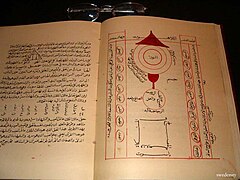Muhammad Ghawth
Muhammad Ghawth | |||||
|---|---|---|---|---|---|
| Personal | |||||
| Born | Muhammad Ghawth Gwaliyari 1500 | ||||
| Died | 1562 (aged 61–62) Gwalior | ||||
| Occupation | Master of Suffism, author, musician | ||||
| Relatives | Attar of Nishapur (ancestor) | ||||
| Senior posting | |||||
| Successor | Ali Sher Bengali | ||||
Students | |||||
| |||||
Muhammad Ghawth (Ghouse,[1] Ghaus or Gwath[2][3]) Gwaliyari (1500–1562) was a 16th-century Sufi master of the Shattari order and Sufi saint, a musician,[4] and the author of Jawahir-i Khams (Arabic: al-Jawahir al-Khams, The Five Jewels). The book mentioning the life and miracles of Gaus named " Heaven's witness" was written by Kugle.[5]
Biography
Muhammad Ghawth was born in Gwalior, India in 1500; the name Gwaliyari means "of Gwalior". One of his ancestors was Fariduddin Attar of Nishapur.[6] In the preface of al-Jawahir al-Khams, he states that he wrote the book when he was 25 years old. In 1549 he travelled to Gujarat, when he was 50 years old. He stayed in Ahmedabad for ten years where he founded Ek Toda Mosque and preached.[7]
Ghawth translated the Amrtakunda from Sanskrit to Persian as the Bahr al-Hayat (The Ocean of Life), introducing to Sufism a set of yoga practices. According to the scholar Carl W. Ernst, in this "translation", Ghawth intentionally reframed these practices with great subtlety to identify "points of contact between the terminologies of Yoga and Sufism".[8]
Ghawth died in Gwalior in 1562.[9] His followers believed that he ascended to heaven and from there was able to direct help down to them; and further, that he was the "axial saint, the pivot of the universe".[9][10]
Tomb at Gwalior
His tomb at Gwalior is famous of its stone lattices (jali) work.[11] The entire structure is enclosed on all sides by the elaborately and delicately carved stone lattice work.[12]
-
Ghawth's Jawahir al-Khams
-
Ghawth's tomb in Gwalior
-
South-east view of tomb
Sufi saeed Ali Shah was the former caretaker of the shrine.[13]
Works
- Jawahir-i-Khamsa (The Five Jewels) which was later translated to Arabic, al-Jawahir al-Khams, by the Mecca-based Shattari teacher Sibghat Allah (d. 1606 CE).[8] In this book Gaus also mentioned about the special creatures known as "Muakkil" which comes under the control of sufis by special Islam chant.[14]
- Bahr al-Hayat (The Ocean of Life), his translation and extension of Hawd al-Hayat (The Pool of Life), an Arabic translation of a lost Sanskrit text on yoga, the Amrtakunda.[15]
References
- ^ Shattari
- ^ Idries Shah, The Sufis ISBN 0-86304-020-9 Octagon Press 1989 pp 335, 367
- ^ Idries Shah, Tales of the Dervishes ISBN 0-900860-47-2 Octagon Press 1993 pp 111-112
- ^ Wade, Bonnie C. (1998). Imaging Sound: An Ethnomusicological Study of Music, Art, and Culture in Mughal India (Chicago Studies in Ethnomusicology). University Of Chicago Press. pp. 113–115. ISBN 0-226-86840-0. See google book search.
- ^ A. Azfar, Moin. The millennial sovereign : sacred kingship and sainthood in Islam.
- ^ "Muḥammad G̲h̲awt̲h̲ Gwaliyārī". Encyclopaedia of Islam (2nd ed.). Brill. 24 April 2012. Retrieved 9 October 2019.
- ^ Achyut Yagnik (2 February 2011). Ahmedabad: From Royal city to Megacity. Penguin Books. p. 42. ISBN 978-81-8475-473-5.
- ^ a b Ernst, Carl W. (1996). "Sufism and Yoga according to Muhammad Ghawth" (PDF). Sufi. 29 (Spring 1996): 9–13. Archived from the original on 8 September 2008.
- ^ a b Kugle, Scott (July 2014). "Body Refined: The Eyes of Muhammad Ghawth". Sufis & Saints' Bodies. North Carolina University Press. pp. 123–180. doi:10.5149/9780807872772_kugle.10. ISBN 9780807830819.
- ^ Kugle, Scott A. (2003). "Heaven's Witness: The Uses and Abuses of Muḥammad Ghawth's Mystical Ascension". Journal of Islamic Studies. 14 (1, January 2003): 1–36. doi:10.1093/jis/14.1.1. JSTOR 26199837. PMC 4199356. PMID 25373148.
- ^ Nonperiodic Octagonal Patterns from a Jali Screen in the Mausoleum of Muhammad Ghaus in Gwalior and Their Periodic Relatives, Emil Makovicky & Nicolette M. Makovicky , Nexus Network Journal volume 19, pages101–120 (2017)
- ^ Jaalis Lattice Screens of India, Asavari Mohdiwale, Smita Agrawal, JETIR May 2021, Volume 8, Issue 5
- ^ sufishattari website 2007.
- ^ Annals of Oriental Research - Volume 32, Part 1 - Page 63.
- ^ Ernst, Carl W. (2016). Chapter 8: Sufism and Yoga according to Muhammad Ghawth. Sage. pp. 121–129. ISBN 978-93-5150-964-6.
{{cite book}}:|work=ignored (help)
External links
| Part of a series on Islam Sufism |
|---|
 |
|
|



